Our highly skilled technicians use the latest state-of-the-art CAD/CAM technology to fabricate the highest quality fixed restorative solutions, ensuring a precision fit and patient satisfaction.
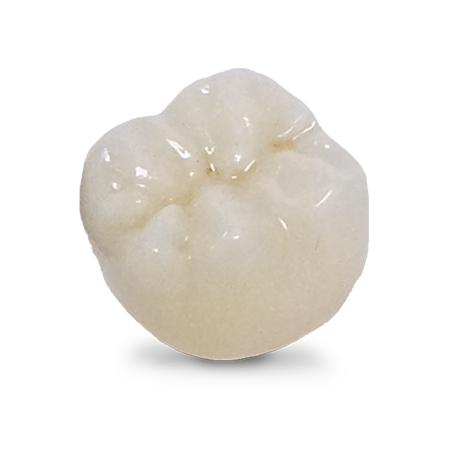
Full-Contour Zirconia
Full-Contour zirconia restorations provide a high level of durability combined with stunning esthetics. FCZ is CAD/CAM fabricated for the most precise fit. With a high flexural strength of 1100 MPa, it provides strength but is gentle on opposing dentition.
Indications
Full-contour zirconia is so versatile, it can be used in almost any situation from singles, bridges with any combination of abutments and pontics, inlay bridges and screw-retained implants. Also an esthetic alternative to a PFM with metal occlusion due to limited space.
Contraindications
When esthetic expectations are high and it is important that the restorations match surrounding natural dentition or other existing restorations. If bonding is necessary to retain the restoration, bond strength is weaker and less predictable than other ceramics.
Preparation
Shoulder preparation not needed. A mild chamfer or a feather-edge margin is good. 1mm buccal, lingual, and occlusal reduction is ideal, but can go to .5mm in some areas when reduction is limited. Minimum occlusal reduction of 0.5 mm; 1 mm is ideal. Adjustments and polishing: Adjust full-contour zirconia crowns and bridges using water and air spray to keep the restoration cool and to avoid microfractures with a fine grit diamond. If using air only, use the lightest touch possible when making adjustments. A football-shaped bur is the most effective for occlusal and lingual surfaces (on anterior teeth); a tapered bur is the ideal choice for buccal and lingual surfaces. Polish full-contour zirconia restorations with the porcelain polishing system of your choice.
Cementation
It is recommended that full-contour zirconia be cemented using a zirconia primer like Z-Prime from Bisco or Clearfil Ceramic Primer from Kuraray. Alternatively, a resin reinforced glass ionomer such as RelyX Luting cement can also be used. When a greater bond is needed due to the lack of a retentive preparation, use a resin cement like RelyX Unicam or RelyX Ultimate. Before cementing all full-contour zirconia crowns, the interior surface of the crown needs to be cleaned with Ivoclean (Ivoclar Vivadent - Amherst, NY). This is critical in assuring maximum bond strength.
Tech Notes
Solid zirconia requires a cast gold type preparation. If adjustments are needed, use zirconia specific diamonds and rubber wheels polishing with diamond paste.
Codes
D2740 Crown – Porcelain/Ceramic Substrate
D6245 Pontic Porcelain/Ceramic
D6740 Abutment Crown Porcelain/Ceramic
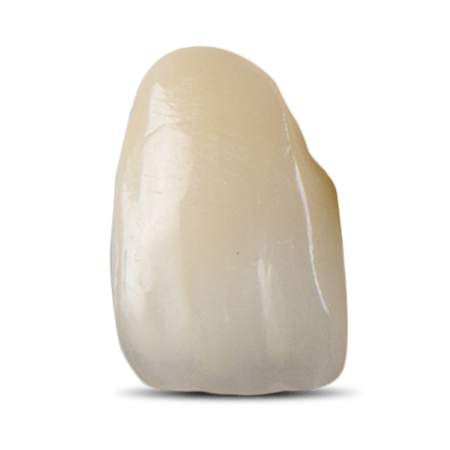
PFZ
Porcelain-fused-to-zirconia delivers strength without the esthetic challenges of porcelain-fused-to-metal, thanks to zirconia’s high translucence. PFZ is also ideal for esthetic restorations because it provides more room for ceramic veneers. PFZ provides a high flexural strength of up to 1450 MPa and is available in all classic and 3D shades.
Indications
A CAD/CAM substitute for traditional PFM, our porcelain-fused-to-zirconia can be used for anterior and posterior crowns, crowns over implants, and bridges of up to fourteen units.
Contraindications
Attachment cases
Cases with less than 1 mm clearance
Bruxism
Patients who have broken a PFM crown
Cases that require bonding
Preparation
The ideal preparation for PFZs is a chamfer margin preparation. If a porcelain labial margin is prescribed, then a shoulder margin preparation is required.
Feather-edge margin preparations are indicated for full-cast restorations.
Cementation
Resin Ionomer cement (RelyX or RelyX Unicem, 3M ESPE)
Maxcem Elite (Kerr)
Panavia F 2.0 (Kuraray) - ideal for short, tapered preparations
Glass ionomer cement (GC Fuji, GC America)
Tech Notes
If an adjustment is required on the ceramic, use a fine diamond with water and air to keep the crown cool.
To contour the ceramic, polish with a pink rubber wheel and diamond polishing paste (Brasseler, Shofu, Vident).
Codes
D2740 Crown - porcelain / ceramic substrate
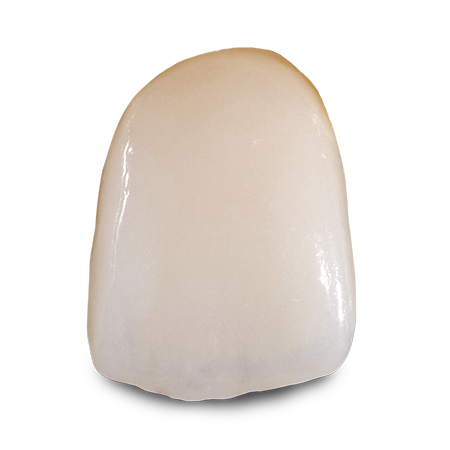
IPS e.max®
The most esthetic of all-ceramic options, this lithium disilicate glass-ceramic offers lifelike translucency. It can be fabricated as full-contour monolithic or cut-back and layered with porcelain for the ultimate in customization. IPS e.max offers minimally invasive restorations with high strength of up to 400MPa and four levels of translucency.
Indications
IPS e.max is the premium lithium disilicate, glass-ceramic restoration. Combining lifelike materials and fracture resistant properties, IPS e.max is as durable as it is lifelike. The flexibility of IPS e.max makes it an excellent restorative method for anterior esthetics or posterior function.
Contraindications
Bridges which include molars, Maryland style bridges, and bridges which have a short vertical height that does not allow for adequate connector height.
Preparation
Anterior full-coverage crowns require a chamfer or shoulder margin. A circular shoulder is prepared with rounded inner edges or a chamfer at an angle of 10-30°: the width of the shoulder/chamfer is approx. 1 mm. Facial reduction is 1.5 – 2 mm; 1 – 1.5 mm lingual contact clearance. Incisal reduction is 1.5 – 2 mm with rounded internal line angles, and an incisal edge at least 1mm wide to permit optimum milling of the incisal edge during CAD/CAM processing.
Posterior full-coverage crown requires a chamfer or shoulder margin. A circular shoulder is prepared with rounded inner edges or a chamfer at an angle of 10-30°: the width of the shoulder/chamfer is approx. 1 mm. Occlusal reduction is 1.5 – 2 mm: axial reduction (buccal, lingual, and interproximal) is 1.5 mm with rounded internal line angles.
Cementation
IPS e.max layered – can be cemented using a resin reinforced glass ionimer such as RelyX Luting cement. Or bonded using a resin cement when extra strength is needed due to lack of retention on the prep, use a resin cement such as RelyX Unicem or RelyX Ultimate.
Tech Notes
If adjustments are needed, use fine diamonds with water and light pressure. Always remove the crown when adjusting or bond/cement crown before adjustments are made.
Codes
D2740 Crown
D2610 Inlay for 1 surface
D2620 Inlay for 2 surfaces
D2630 Inlay for 3 surfaces
D2962 Labial Veneer
D2783 Crown 3/4 Porcelain Ceramic (does not include veneers)
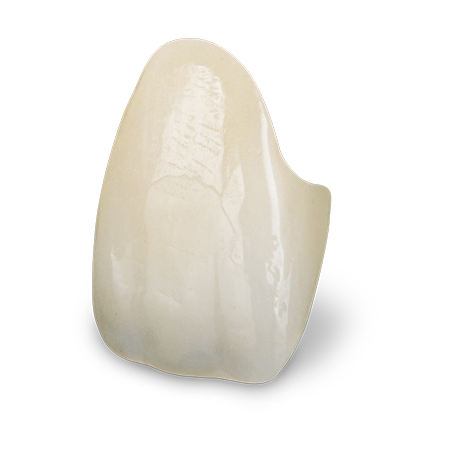
Argen ST
Argen ST is a cubic zirconia material with 50% higher translucency than conventional zirconia and a flexural strength of 850 MPa. This highly esthetic alternative to lithium disilicate delivers characteristics of both strength and beauty.
Indications
Argen ST is indicated for single crowns and 3-unit bridgework in all tooth positions.
Contraindications
Preparation
Argen ST requires less tooth preparation than is required for lithium disilicate. Ideally, a .8 mm chamfer or rounded shoulder prep is preferred, however a feather-edge margin is acceptable with 1.0 – 1.5 mm occlusal reduction.
Cementation
Ceramir® Crown & Bridge (Doxa Dental) or a resin-reinforced glass ionomer cement such as RelyX™ Luting Cement (3M ESPE) or GC Fuji Plus™ (GC America)
For short or over-tapered preparations, use a resin cement such as RelyX Unicem (3M ESPE) or Panavia™ F2.0 (Kuraray)
Tech Notes
Adjustment of occlusion using football-shaped finishing diamond Recommended speed: 100K rpm
Codes
D2740 Crown – Porcelain/Ceramic Substrate
D6245 Pontic Porcelain/Ceramic
D6740 Abutment Crown Porcelain/Ceramic
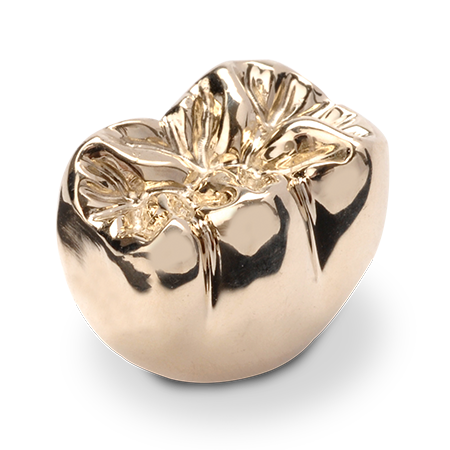
Full-Cast Crown
Full-cast crowns have long been a popular choice due to their clinical success, biocompatibility, and ease of use. CAD/CAM fabrication ensures a high-quality, consistent fit and finish. Noble and high noble alloys make full cast durable yet gentle on opposing dentition.
Indications
Full-cast gold crowns are indicated for crowns, veneers, inlays, onlays, and bridges.
Contraindications
Full-cast gold crowns are contraindicated for partials and implants.
Preparation
Inlays and onlays can also be fabricated as a full-cast restoration. Feather-edge margin preparations are indicated for full-cast restorations, but any margin preparation may be used.
Cementation
Panavia 21 (Must be tin plated if precious metal is used)
Glass ionomer cement (GC Fuji, GC America)
Zinc Phosphate Polycarboxylate Resin Ionomer cement (RelyX, 3M ESPE)
Tech Notes
All castings are made with a metal alloy, be it non-precious, semi-precious or precious metals. Alloys are classified by their content.
Base – contents include non-precious, Chrome Cobalt or Titanium
Noble – consists of 25 percent precious alloy
High Noble – consists of 60 percent precious metal with at least 40 percent being gold
Alloy type refers to the hardness and/or softness of the material.
Type I – Extra soft
Type II – Soft
Type III– Hard
Type IV – Extra Hard (Rigid)
Non-Precious, Noble 20, White High Noble – Type IV – Very hard and rigid. These crowns are more difficult to adjust and re-polish than alloys with a high gold content.
Full Cast 40 – Type III – Yellow high noble alloy. Brand name currently used is Argenco 40 HN.
Full Cast 52 HN – Type III – Yellow high noble alloy. Brand name currently used is Argenco 52.
Full Cast 75- Type III – Yellow high noble and is an upgrade from full cast 52. The gold is slightly more yellow in color. Brand name currently used Argenco 75.
Codes
D2790 Crown Full-Cast High Noble Metal
D2791 Crown Full-Cast Predominantly Base Metal
D2792 Crown Full-Cast Noble Metal
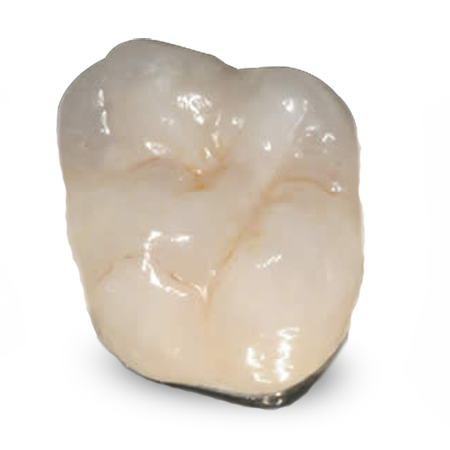
PFM
The traditional porcelain-fused-to-metal restoration remains a tried-and-true option. PFM is available in both noble and high noble alloys. With the marriage of PFM materials and today’s CAD/CAM technology, this traditional option continues its popularity with new precision.
Indications
Our PFMs can be used for crowns and bridges (up to fourteen units). PFMs can be manufactured to nonprecious, semiprecious, and yellow high noble copings and can be used in conjunction with cast partials and implants.
Contraindications
Contraindicated when the patient has a metal allergy or when the size of the tooth pulp is negligibly smaller, thus compromising the tooth preparation process. It is also contraindicated when the clinical tooth crown is very short and lacks the required stability including retention that is enough to provide the space for porcelain and metal.
Preparation
The ideal preparation for PFMs is a chamfer margin preparation. If a porcelain labial margin is prescribed, then a shoulder margin preparation is required.
Feather-edge margin preparations are indicated for full-cast restorations.
Cementation
Panavia 21 – tin plated
Glass ionomer cement (GC Fuji, GC America)
Zinc Phosphate Polycarboxylate
Resin Ionomer cement (RelyX, 3M ESPE)
Tech Notes
If an adjustment is required on the ceramic, use a fine diamond with water and air to keep the crown cool. To contour the ceramic, polish with a pink rubber wheel and diamond polishing paste (Brasseler, Shofu, Vident).
Codes
D2750 Crown Porcelain fused to high noble
D2751 Crown Porcelain fused to nonprecious
D2752 Crown Porcelain fused to semiprecious
D6750 Crown Porcelain fused to high noble (bridge units)
D6751 Crown Porcelain fused to nonprecious (bridge units)
D6752 Crown Porcelain fused to semiprecious (bridge units)

Veneers
Our custom veneers are an effective cosmetic option that beautifully renews the appearance of cracked, chipped, misaligned, or discolored teeth.
Indications
Changed color of anterior teeth, Incorrect shape of tooth or position in dental arch, Enamel defects such as enamel hypoplasia, attrition of teeth as a consequence of trauma, wide interproximal spaces like diastema
Contraindications
Bruxism and parafunction, Pathology of bite, more than 50% of enamel affected by pathology
Preparation
Cementation
Tech Notes
For facial reduction three wheel diamond depth cutter should be used for orientation grooves. For proximal reduction - round end tapered diamond bur is used as an extension for facial reduction.
Codes












